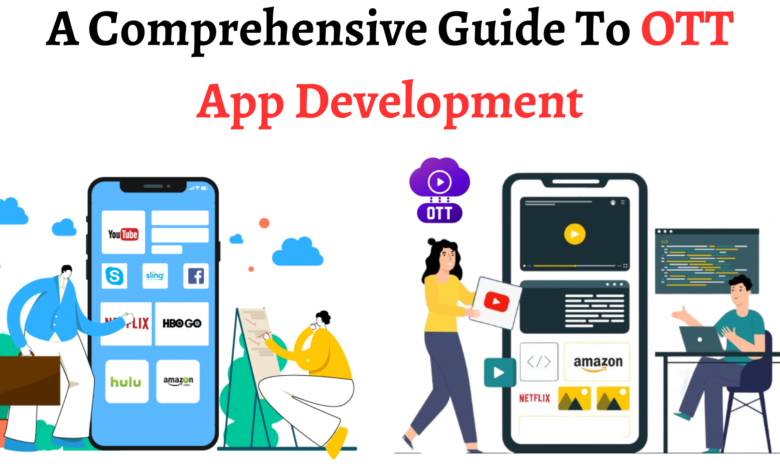
In the digital age, Over-the-Top (OTT) platforms have revolutionized the way we consume media. Whether it’s binge-watching TV series, streaming live sports, or catching up on the latest movies, OTT platforms have reshaped the entertainment landscape, offering users direct access to content across devices. With the growing demand for on-demand, personalized content, OTT platform development has become a thriving field. The process of developing an OTT platform is an intricate one, weaving together robust technology, seamless user experience, content management, and monetization strategies. This article will navigate the essential components of OTT platform development, covering key stages from “code to content.”
1. The Rise of OTT Platforms
Before diving into the development process, it’s essential to understand the rise and relevance of OTT platforms. Over the last decade, the traditional broadcasting model has given way to digital streaming services. With faster internet speeds, affordable data plans, and the proliferation of smart devices, OTT platforms have emerged as a preferred medium for content consumption. Giants like Netflix, Amazon Prime Video, Disney+, and Hulu have set the stage, and new platforms are constantly joining the fray.
The driving force behind OTT platform development is the shift in consumer behavior. Audiences are now seeking content flexibility, personalized recommendations, and seamless viewing experiences. This demand for convenience and customization has pushed developers to create platforms that cater to user preferences while ensuring high-quality streaming.
2. Key Components of OTT Platform Development
Developing an OTT platform is a multifaceted process that requires a blend of technology, content strategy, and business acumen. Below are the key components involved in building an OTT platform.
a. Platform Architecture and Infrastructure
The foundation of any OTT platform is its architecture. The platform needs to be designed to handle high traffic volumes, offer seamless streaming experiences, and ensure minimal buffering. This is where cloud infrastructure plays a crucial role. Using cloud services like AWS (Amazon Web Services), Google Cloud, or Microsoft Azure, OTT platforms can leverage scalable storage and processing capabilities. These services help with content delivery, user data management, and real-time analytics.
Developers must also focus on Content Delivery Networks (CDNs) to ensure the smooth delivery of video streams. CDNs minimize latency and distribute content efficiently by placing servers closer to the user’s geographic location. An optimized architecture with a strong CDN helps maintain video quality even during peak times.
b. Video Encoding and Transcoding
Once content is created, it needs to be transformed into formats compatible with different devices and networks. This process is called video encoding and transcoding. Encoding converts raw video into digital formats, while transcoding involves converting video from one format to another. The goal is to ensure that the content can be streamed across various devices such as smartphones, tablets, desktops, and smart TVs without compromising quality.
Multiple codecs (such as H.264, H.265) are used to encode videos, optimizing them for bandwidth and device compatibility. Adaptive Bitrate Streaming (ABR) is another key feature that adjusts video quality based on the viewer’s internet speed, ensuring uninterrupted playback.
c. User Interface (UI) and User Experience (UX)
The user interface and experience are crucial to an OTT platform’s success. A poorly designed interface can drive users away, no matter how good the content is. OTT platforms should offer intuitive navigation, easy search functionality, personalized recommendations, and seamless playback. From signing up to watching content and managing subscriptions, the journey should be smooth and engaging.
Developers often employ advanced algorithms to power content recommendations based on viewing history, preferences, and behavioral patterns. Personalization is a key driver of user engagement and retention. A sleek, responsive design that adapts to different screen sizes and orientations is critical for user satisfaction.
d. Content Management System (CMS)
A robust Content Management System (CMS) is essential for OTT platform development. The CMS serves as the backbone for uploading, managing, and organizing the content. It allows administrators to easily manage the platform’s content library, including videos, images, descriptions, and metadata.
The CMS should also support various content categories such as live streaming, video-on-demand (VOD), and pay-per-view (PPV). Automation features for content scheduling, publishing, and archiving streamline operations. Moreover, a powerful CMS should allow content creators and managers to implement and track SEO strategies for better content discoverability.
e. Monetization Models
One of the most critical aspects of OTT platform development is the monetization strategy. There are several revenue models OTT platforms can adopt:
- Subscription-Based (SVOD): Users pay a recurring fee (monthly or annually) for access to a content library. Netflix is the prime example of this model.
- Ad-Supported (AVOD): The platform offers free content but generates revenue through advertisements. YouTube follows this model.
- Transaction-Based (TVOD): Users pay for specific content, such as a movie rental or purchase. Apple TV+ and Google Play use this model.
- Hybrid Model: Some platforms combine these models, offering both subscription and ad-supported options, like Hulu.
Choosing the right monetization model depends on the target audience, content type, and long-term business goals. Integration with payment gateways for seamless transactions is crucial for ensuring a frictionless user experience.
f. Security and Digital Rights Management (DRM)
Security is paramount in OTT platform development. With growing concerns over piracy and unauthorized content sharing, implementing robust Digital Rights Management (DRM) solutions is essential. DRM restricts access to content based on user permissions, preventing illegal downloads and distribution. Popular DRM solutions include Google Widevine, Microsoft PlayReady, and Apple FairPlay.
In addition, secure authentication protocols like OAuth and SSO (Single Sign-On) ensure user data is protected, and encryption protocols safeguard content transmission.
3. Challenges in OTT Platform Development
OTT platform development comes with its own set of challenges, especially as the competition in the market grows. Some of the key hurdles include:
a. Scalability
As user bases grow, platforms must handle increased traffic without compromising on performance. Scalability requires not only robust cloud infrastructure but also intelligent load balancing and dynamic scaling mechanisms. Developers need to anticipate peak usage times and ensure their platforms can handle the load without downtime.
b. Content Acquisition and Licensing
Securing high-quality content is critical for an OTT platform’s success. Licensing agreements with studios, production companies, and content creators can be complex and costly. Moreover, platforms need to continuously acquire fresh content to retain and grow their user base.
c. Global Reach and Localization
For platforms targeting global audiences, localization is essential. This involves translating content into different languages, offering subtitles, and ensuring content meets the cultural and legal standards of different regions. This requires significant investment in both content and technology.
d. User Retention
Keeping users engaged is an ongoing challenge. While attracting new users is important, retaining them requires a combination of personalized content recommendations, regular content updates, and a user-friendly experience. User churn is a major concern for OTT platforms, and constant optimization is required to reduce churn rates.
4. The Future of OTT Platform Development
As technology continues to advance, the future of OTT platforms looks promising. Emerging trends such as Artificial Intelligence (AI), Machine Learning (ML), and Augmented Reality (AR) will enhance content personalization and user engagement. AI-driven recommendation engines will become even more sophisticated, offering hyper-personalized viewing experiences.
Additionally, 5G technology will revolutionize OTT streaming by enabling faster, more reliable content delivery, especially for high-definition and live streaming. With faster internet speeds, users can expect lower latency and better streaming quality, further enhancing their viewing experience.
Another potential future development is the integration of blockchain technology in OTT platforms. Blockchain can improve content security, streamline payment processes, and provide transparency in content distribution.
Conclusion
OTT platform development is a complex yet rewarding process that requires careful planning, innovative thinking, and a deep understanding of technology and user behavior. From building robust backend architecture to creating a seamless user interface and ensuring content security, every aspect plays a crucial role in the platform’s success. As consumer demand for on-demand, personalized content continues to rise, OTT platforms will remain at the forefront of the digital entertainment revolution.
By successfully navigating the journey from code to content, developers can create platforms that not only cater to modern audiences but also stand out in an increasingly competitive market.


